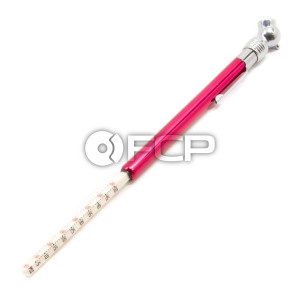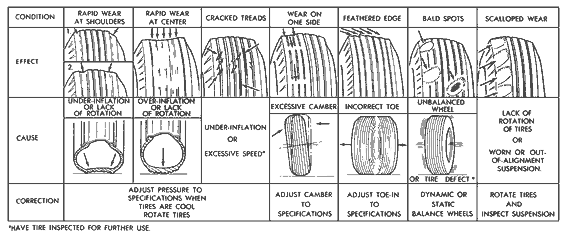- 11/05/2014
- 2 Min Read
- By: Dan Bullmore
Basic Tire Maintenance & How it Can Save You Money
Discussing tires elicits different responses from different people. Some people will leap headfirst into a discussion about what brands they like the most, what tread patterns and season designs they have had the most luck with, and what places offer the best deals. Others, though, will have a hard time seeing why tires should be such a big deal, and often blow them off as a better-deferred expense when a cheap tire will “do the job”. To many drivers, once the tires are mounted, they won't think about them again until one flops off on the side of the road, or they pick up a nail, or scrub a curb. This is a very nonchalant approach to the only thing standing between your vehicle and the pavement. Poor tires can harm your fuel efficiency, suspension response, and perhaps most importantly, your brake efficiency. It pays to learn a little bit about tire maintenance and how to get the most out of them, even if only to save money in the long run.
Overinflation can cause the tread to bow out
Inflation is perhaps the most important aspect to properly maintaining your tires. An underinflated tire will increase the size of the contact patch that the tire makes with the road. This increased contact patch increases the rolling friction experienced by the wheel, and therefore decreases fuel efficiency - often very drastically. Furthermore, an underinflated tire exposes more of the tire to the pavement at any given time, increasing the wear rate of the tire or worse, exposing sidewall to the pavement, as the sidewall is not designed for that kind of contact. An overinflated tire causes other related issues. A tire that is overinflated will have a diminished contact patch, which can cause decreased grip as well as cornering and braking difficulty. Overinflation can also cause the tire tread to bow out in an unusual way, causing heavy wear in the centers rather than towards the edges of the tread. Overinflation can also cause the tire to burst, as heat, either ambient or collected from friction with the road, will cause the pressure inside the tire to increase even further. A bursting tire can cause immediate loss of control, as well as body damage from flying debris- if it doesn't cause a crash in the first place. Best practice is to use the exact tire size specified by the vehicle manufacturer, and to follow the vehicle manufacturer's suggested tire pressure values. Modern vehicles that have a TPMS or Tire Pressure Monitoring System will notify you if the tire pressures drop below a preset threshold, but older vehicles must rely on the diligence of the operator. Checking your tire pressures at each fuel filling is an excellent practice, and a quality tire gauge is not as expensive as it may seem.
Destroying the tread is an expensive suspension check
 Periodic observation of your tires, including checking for tread depth should be carried out to ensure the tires are in optimum condition (consult the manufacturer for suggestions, as some manufacturers include wear markers on the tires themselves). Search for gouges, scrapes, missing rubber, or irregularities in the tread. Often, irregularities in the tread can point to other mechanical failures in the vehicle, including poor alignment, damaged suspension components, or failed shock absorbers. Destroying the tread of a tire is an expensive way to check for suspension wear, but if your suspension or steering is out of adjustment, damage to the tread is often an early indicator. Sidewall damage is especially serious, as the sidewall is not typically as thick or sturdy as the tread of the tire, and is more susceptible to catastrophic failure in the event of a puncture or uneven wear.
Periodic observation of your tires, including checking for tread depth should be carried out to ensure the tires are in optimum condition (consult the manufacturer for suggestions, as some manufacturers include wear markers on the tires themselves). Search for gouges, scrapes, missing rubber, or irregularities in the tread. Often, irregularities in the tread can point to other mechanical failures in the vehicle, including poor alignment, damaged suspension components, or failed shock absorbers. Destroying the tread of a tire is an expensive way to check for suspension wear, but if your suspension or steering is out of adjustment, damage to the tread is often an early indicator. Sidewall damage is especially serious, as the sidewall is not typically as thick or sturdy as the tread of the tire, and is more susceptible to catastrophic failure in the event of a puncture or uneven wear.
Find a reputable tire dealer
When purchasing a tire, as with all things, research can save you a lot more money than a sale. Often times, inexpensive tires do hold up well and demonstrate decent quality, but at least as often, the cheapest tire will be more expensive in the long run - either because of early failure, premature wear, degradation of the rubber, or a number of other possibilities. Learning from others' experience with a particular tire can help you avoid purchasing a cheap tire that will cost you a fortune. On the other hand, a very expensive tire is not necessarily a good tire, nor is it necessarily the tire you should buy. Each driver and each vehicle will have different demands from their tires, and the best defense you have against a regrettable purchase is knowledge. One suggestion I would make to everyone is to find a reputable tire dealer in your area - one with competent, trained technicians that can help you make the best decisions for you and your vehicle. Your tires will pay you back mile after mile!
 Dan Bullmore is a physicist and engineer from Houston, TX. Preferring the old to the new, Dan has owned many examples of Mercedes and Volvo vehicles and has devoted much of his time to maintaining and understanding them.
Dan Bullmore is a physicist and engineer from Houston, TX. Preferring the old to the new, Dan has owned many examples of Mercedes and Volvo vehicles and has devoted much of his time to maintaining and understanding them.













